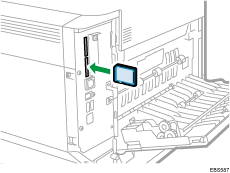Importing or Exporting the Device Setting Information
You can export the machine's device information to an SD card as a device setting information file (CSV file). You can also specify the device setting information file to store in the server, and import it to the machine. This function enables to apply the same settings as the machine to another device of the same model.
![]()
- Keep SD cards or USB flash memory devices out of reach of children. If a child accidentally swallows an SD card or USB flash memory device, consult a doctor immediately.
![]()
Only the administrator with privileges to manage devices, users, networks, and files can import or export the device setting information file.
During other operation, the machine cannot import or export.
Data That Can Be Imported and Exported
Some of the device setting data can be imported or exported as a device setting information file, and the others cannot.
Data that can be imported and exported
Paper Input
Maintenance
System
Print Settings
Security Options
Remote Services
Host Interface
Web Image Monitor Setting (Setting of a management tool installed on this machine to monitor this machine or configure settings for this machine by using a web browser)
Web Service Settings
Data that cannot be imported or exported
Address book
Programs
Settings that can be specified via telnet
@Remote-related data
Counters
Settings that can only be specified via Web Image Monitor or Web Service (for example, Bonjour, SSDP setting)
Settings for the date and time
Settings that require the device certificate
Settings that need to be adjusted for each machine (for example, image adjustment settings)
Settings exclusively for executing functions and settings exclusively for viewing
Exporting the Device Setting Information to an SD Card
![]() Turn off the machine.
Turn off the machine.
![]() Turn on the machine.
Turn on the machine.
![]() Press the [Menu] key.
Press the [Menu] key.
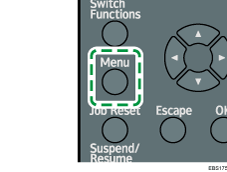
![]() Log in to the machine as the administrator with all privileges on the control panel.
Log in to the machine as the administrator with all privileges on the control panel.
![]() Select [Device Setting Information], and then press the [OK] key.
Select [Device Setting Information], and then press the [OK] key.
![]() Select [DevSettgInfo: Exp (MemDev)], and then press the [OK] key.
Select [DevSettgInfo: Exp (MemDev)], and then press the [OK] key.

![]() Select [Device Unique Information], and then press the [OK] key.
Select [Device Unique Information], and then press the [OK] key.
![]() Select [Include] or [Exclude], and then press the [OK] key.
Select [Include] or [Exclude], and then press the [OK] key.
Specify whether to export the "Device Unique Information". The "Device Unique Information" includes the IP address, host name, etc.
![]() Select [Enter Encryption Key], and then press the [OK] key.
Select [Enter Encryption Key], and then press the [OK] key.
![]() Select [Yes], and then press the [OK] key.
Select [Yes], and then press the [OK] key.
![]() Press the [
Press the [![]() ] or [
] or [![]() ] key to select a character for the encryption key, and then press the [OK] key to enter the character. Repeat this to complete the encryption key, and then press the selection key beneath [Accept].
] key to select a character for the encryption key, and then press the [OK] key to enter the character. Repeat this to complete the encryption key, and then press the selection key beneath [Accept].

To enter upper-case letters, numerals, or symbols, press the selection key beneath [ABC/123].
To delete a character that has been entered, press the selection key beneath [Delete].
![]() Press the selection key beneath [Enter].
Press the selection key beneath [Enter].
![]() Follow the instructions in Step 13 to re-enter the encryption key, and then press the selection key beneath [Accept].
Follow the instructions in Step 13 to re-enter the encryption key, and then press the selection key beneath [Accept].
![]() Press the selection key beneath [Export] twice.
Press the selection key beneath [Export] twice.
![]() Press the selection key beneath [Exit].
Press the selection key beneath [Exit].
![]() Turn off the machine, and then remove the SD card.
Turn off the machine, and then remove the SD card.
![]()
If the desired menu item is not on the screen, press the [
 ] or [
] or [ ] key on the control panel until it appears.
] key on the control panel until it appears.If export fails, you can check the log for the error. The log is stored in the same location as the exported device setting information file.
Importing the Device Setting Information from an SD Card
![]() Turn off the machine.
Turn off the machine.
![]() Turn on the machine.
Turn on the machine.
![]() Press the [Menu] key.
Press the [Menu] key.

![]() Log in to the machine as the administrator with all privileges on the control panel.
Log in to the machine as the administrator with all privileges on the control panel.
![]() Select [Device Setting Information], and then press the [OK] key.
Select [Device Setting Information], and then press the [OK] key.
![]() Select [DevSettgInfo: Imp (MemDev)], and then press the [OK] key.
Select [DevSettgInfo: Imp (MemDev)], and then press the [OK] key.

![]() Select [Select Devc Setg Info File], and then press the [OK] key.
Select [Select Devc Setg Info File], and then press the [OK] key.
![]() Press the [
Press the [![]() ] or [
] or [![]() ] key to select the file you want to import, and then press the [OK] key.
] key to select the file you want to import, and then press the [OK] key.
![]() Select [Device Unique Information], and then press the [OK] key.
Select [Device Unique Information], and then press the [OK] key.
![]() Select [Include] or [Exclude], and then press the [OK] key.
Select [Include] or [Exclude], and then press the [OK] key.
Specify whether to import the "Device Unique Information". The "Device Unique Information" includes the IP address, host name, etc.
![]() Select [Enter Encryption Key], and then press the [OK] key.
Select [Enter Encryption Key], and then press the [OK] key.
![]() Press the [
Press the [![]() ] or [
] or [![]() ] key to select a character for the encryption key, and then press the [OK] key to enter the character. Repeat this to complete the encryption key, and then press the selection key beneath [Accept].
] key to select a character for the encryption key, and then press the [OK] key to enter the character. Repeat this to complete the encryption key, and then press the selection key beneath [Accept].

To enter upper-case letters, numerals, or symbols, press the selection key beneath [ABC/123].
To delete a character that has been entered, press the selection key beneath [Delete].
![]() Press the selection key beneath [Import].
Press the selection key beneath [Import].
![]() Press the selection key beneath [Yes].
Press the selection key beneath [Yes].
![]() Press the selection key beneath [Exit].
Press the selection key beneath [Exit].
The machine restarts.
![]() Turn off the machine, and then remove the SD card.
Turn off the machine, and then remove the SD card.
![]()
If the desired menu item is not on the screen, press the [
 ] or [
] or [ ] key on the control panel until it appears.
] key on the control panel until it appears.If import fails, you can check the log for the error. The log is stored in the same location as the device setting information file in the SD card.
Importing a Device Setting Information from the Server
You can create a central management instruction file to import the device information stored on a server into the machine automatically.
Use the Web server or device management server to import the device setting information. To use the device management server, see the device management server manual.
To use the web server, open the device setting information CSV file, change the data displayed under "ModuleID" to "-", and then store it on the Web server.
The steps below use the Web server for example.
![]() Download the format for the central management instruction file from the machine.
Download the format for the central management instruction file from the machine.
Enter "http://(IP address of the machine or host name)/DH/directionsFormat.ini" in the address bar of the Web browser to download the format file.
![]() Create a central management instruction file following the instructions below and store it on a Web server.
Create a central management instruction file following the instructions below and store it on a Web server.
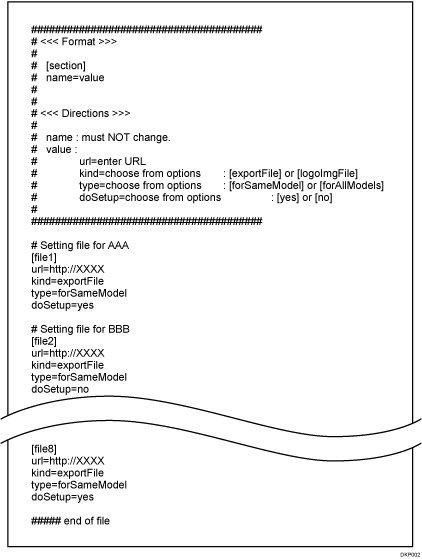
Section
Type the section number for each device setting information file in the form of [file 1], [file 2], [file 3] and so on. The maximum number of sections are eight. If the number of sections exceeds eight, the ninth and succeeding sections are ignored.
Settings
Configure each device setting information file. The text string before "=" is the name of the setting and after "=" is the setting value. Do not change the names of settings.
Name
Value
url
Type the URL of the device setting information file. The maximum length is 255 characters.
kind
Type "exportFile".
"logoImgFile" cannot be used on this machine.
type
Type "forSameModel".
"forAllModels" is for device management servers.
doSetup
Type "yes" to import the corresponding device setting information file; type "no" not to import the corresponding device setting information file.
Comment
If you start a line with a "#", the line will be recognized as a comment line and ignored during the import process.
![]() After storing the central management instruction file on the Web server, log in to the machine as the machine administrator with all privileges from Web Image Monitor.
After storing the central management instruction file on the Web server, log in to the machine as the machine administrator with all privileges from Web Image Monitor.
![]() Click [Configuration] from the [Device Management] menu.
Click [Configuration] from the [Device Management] menu.
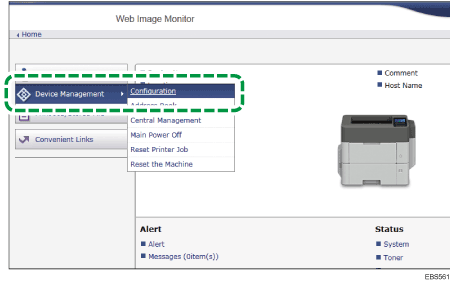
![]() On the "Configuration" screen, click [Device Setting Information: Import Setting (Server)] of "Device Settings".
On the "Configuration" screen, click [Device Setting Information: Import Setting (Server)] of "Device Settings".
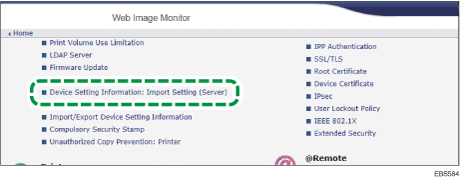
![]() Configure the import conditions.
Configure the import conditions.
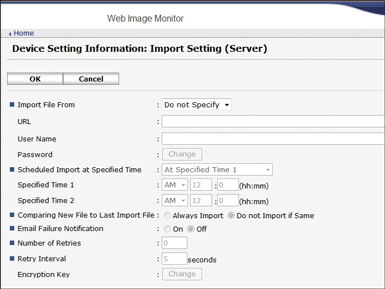
Import File From: Select the server for importing device setting information files. Specify the URL of the server where the central management instruction file and device setting information files are stored, and the login user name and password of the user who accesses the URL. If the specified login user name and password are of a user with no access privileges, importing fails.
Scheduled Import at Specified Time: Select the frequency and specify the time for importing device setting information files.
Comparing New File to Last Import File: Specify whether or not to import a device setting information file if it is identical as the last imported file.
Email Failure Notification: Specify whether or not to send an e-mail notification to the administrator when importing fails. To use Email Notification, it is necessary to specify "Auto Email Notification" in Web Image Monitor.
Number of Retries: Specify the number of retries when importing fails. Enter a value between "0" and "30".
Retry Interval: Specify the interval between the retries when importing fails in seconds. Enter a value between "5" and "300".
Encryption Key: To import a device setting information file that is encrypted, specify the encryption key. If the specified encryption key is incorrect, importing fails.
![]() Click [OK].
Click [OK].
![]() Click [Logout] and exit the Web browser.
Click [Logout] and exit the Web browser.
![]()
When importing multiple device setting information files, the files will be imported in the order of appearance in the central management instruction file. If the machine fails to import a device setting information file, it proceeds to the next device setting information file.
If importing fails, this is recorded in the access log.

